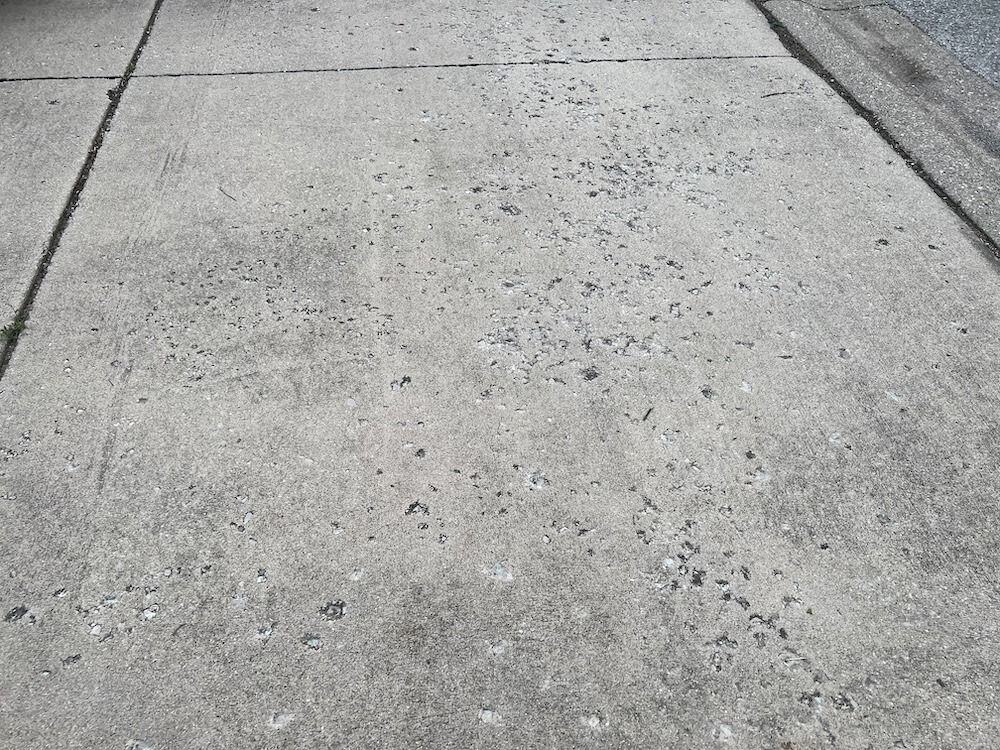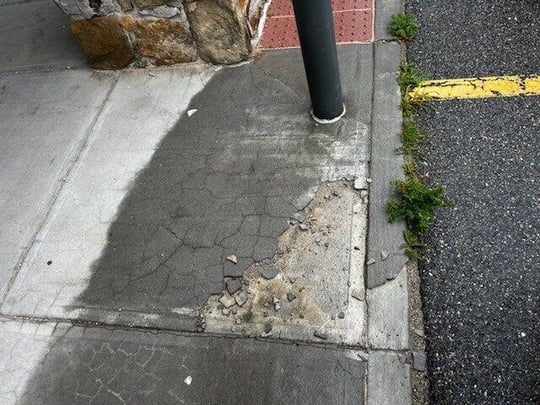Concrete Spalling: Causes, Prevention, Repair Options, and More
June 24th, 2024 | 3 min. read
By Sarah Etler

Learn everything you need to know about an extremely common concrete problem: spalling.
If you've noticed chipping, flaking, or peeling sections in your concrete, you’re likely dealing with surface spalling.
Concrete spalling is an extremely common problem that can happen to concrete at any stage – old or new.
This article will guide you through what exactly spalling concrete is, its causes, dangers, repair options, and preventive measures.

What Is Concrete Spalling?
Concrete spalling refers to the deterioration of the concrete surface, usually as pitting, chipping, flaking, or peeling sections. These damaged areas can be small and localized or can cover large portions of a slab.
Problems With Spalling Concrete
As concrete spalls, the pores in the concrete surface open up, allowing more water to penetrate, freeze, and expand in freezing weather. This can lead to worsening spalling and cracks as the concrete undergoes continuous freeze-thaw cycles.
Also, beyond just looking bad, deeply pitted and spalled patches can be trip hazards.
Causes of Concrete Spalling
Understanding the causes of concrete spalling is crucial in addressing and preventing it. Here are some common causes:
-
Freeze-Thaw Cycles
Concrete is porous and absorbs water. When temperatures drop, the absorbed water freezes and expands, causing the concrete pores to “pop” and deteriorate, both on the surface and from the inside. Repeated freeze-thaw cycles exacerbate this damage.
-
Poor-Quality Concrete
Concrete with incorrect ratios of ingredients is more prone to spalling. Typically concrete is more prone to spalling if there is not enough Portland cement in the original mix. High-quality concrete, when mixed and cured properly, can last for decades.
-
Deicing Salts
The chemical reaction between deicing salts and concrete can lead to deterioration. Salt mixes with water and is absorbed into the concrete, breaking it down from the inside and worsening freeze-thaw damage.
-
Corrosion and Oxidation of Rebar
When rebar within the concrete is exposed to water, it can rust and expand, causing internal pressure that leads to spalling.
-
Concrete Installation Practices
Concrete installation practices are extremely important for ensuring concrete for spalling prevention.
Spalling can result from poor finishing practices or weather/temperature factors during the curing process. Extreme heat or cold can be the most common factors that lead to spalling.
Spalling Concrete Repair Options
Unfortunately, beyond completely replacing the concrete, there is no permanent fix for concrete spalling. Below are some options for temporary repairs and ways to slow the progression of spalling:
Penetrating Sealer
The best option for slowing down spalling is using a penetrating sealer. It chemically binds with the concrete, creating a barrier that protects against moisture and freeze-thaw cycles.
Topical Sealers
While some believe that covering spalled concrete with a thick topical sealer will prevent further deterioration, this method often leads to bad-looking white splotches and does not stop the spalling.

Concrete Overlays
Applying a thin layer of resurfacing compound over the spalled area can temporarily improve appearance, but it doesn't address the underlying cause and may not last long.

Concrete Replacement
Again, replacing the affected slab is the only permanent solution, but it involves significant effort, cost, and the potential for the spalling to happen again (among other risks) if not done correctly.
Pro Tip: Although you cannot truly undo spalling once it has started, addressing it as soon as possible after noticing it can help mitigate its effects and prolong the life of your concrete.
Preventing Spalling Concrete
Preventive measures from the get-go are crucial in protecting your concrete from spalling:
Proper Initial Maintenance
Cleaning and sealing concrete soon after installation can help prevent spalling. Penetrating sealers are particularly effective in creating a moisture barrier that protects against spalling.
Related Resource: How To Maintain Your Concrete
Regular Cleaning and Sealing
Routine maintenance, including cleaning and reapplying sealers, can extend the life of your concrete and protect it from spalling.
Caulking Cracks
Sealing cracks with a specialized polymer caulk can prevent water from entering and causing erosion or other freeze-thaw damage.
Dealing With Concrete Spalling
Concrete spalling is a common yet preventable issue. By understanding its causes and implementing effective repair and preventive measures, you can maintain the durability and appearance of your concrete surfaces.
If you're dealing with spalling or want to minimize the chances of it from spreading, consider sealing it with a high-quality penetrating concrete sealer.
Many of our A-1 Concrete Leveling locations offer concrete cleaning and sealing services. Find your nearest location to see if this service is offered near you and request a free onsite cost estimate!
Sarah Etler joined A-1 Concrete Leveling after receiving her Bachelor of Arts degree in English from Northern Kentucky University. As A-1's Content Marketing Manager, she works closely with industry experts to produce content that will best answer questions related to concrete repair and maintenance practices. Sarah loves living a life full of discovery and is excited every day to see what new things she can learn and share with those around her.
Topics: